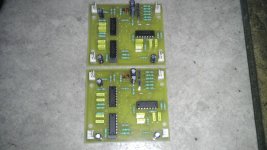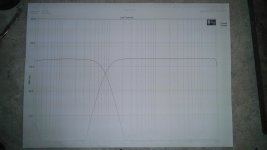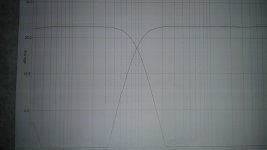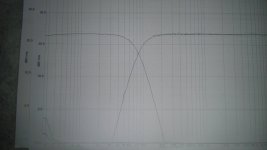Ikea Omni Bowl Speakers
Havent seen such, although there is 100% probability that someone already did it.
It is a medium/low budget project that can be done even cheaper or can be really expensive. In the current case it'll have it's own amplifiers and active filters in one box, but that is not an actual part of it.
I have read all recent megatopics here and also have own long time considerations. The ideal directivity for a stereo speakers and the other one with the falling HF response and other such. Not to mention topics about time alignment and phase.
It seems that the Ikea Omni Bowl Speakers solve everything by adding much less sophistication than the one of the problems it solves. It even allows and makes advantage of the rising HF response of a fullrange if there is such.
Practically it's a three way, but actually it's a FAST.


There are 40, 120, 180 (or was it 200) and 280mm Ikea stainless steel bowls. They have very small bottoms - ideal for installing a dome tweeter facing downwards.
Here is a dome tweeter that is suitable for Omni, or at least it is used in one Visaton - Lautsprecher und Zubehör, Loudspeakers and Accessories
Visaton - Lautsprecher und Zubehör, Loudspeakers and Accessories
Here is the crossover: http://www.visaton.de/bilder/weichen/gross/fontana_w.gif
The midbass does not have a rising response and they make it with the crossover.
With any omni speaker, you get a falling HF response, because what was beamed before, now is reflected in 360 degrees, so at any given point you'll be able to measure the overall energy distribution across the frequency band. And the overall energy falls towards the HF.
My humble estimates call for about 3 db per octave reduction of the SPL towards the high frequencies. But that is when measured from a single point with a directional microphone. The overall energy emitted in the room will be the same, so the rule that the treble should be slightly rolled off that is followed by many is not defeated.
Even with a driver with rising response, you'll (or should) get quieter on axis treble, but more treble energy and less severe reverberation.
I'll do the following:
- Two stereo amplifiers
- Active LR-4 crossover at 90 hz
- Linkwitz Transform matched to the response of Cerwin Vega WOFH-12203 (+15 db@25hz) in a 50L stuffed sealed cabinets I won't push it further than +15 db as I was told it was not advisable to go more than +20db and because 25hz@0db is a great parameter. I got luck with the woofers as it occurred that they are freely interchangeable with ''12 woofers of lockal make that I prefer. - see the bb sim, there are actually two sims in the screenshot, they are one over another.
+ if it is true that the Linkwitz Transform pushes the group delays even lower in frequency it'll be great, 1.5 ms@40 hz sounds tempting.
- A pair of 12 inch fullrange drivers (local make, absolutely freely interchangeable for 8 or 12 inch Audio Nirvana of 8 inch Fostex or whatever)
- A pair of dome tweeters with rising response crossed over to the extended range ''12 with a single cap somewhere above 10-12 khz, they will be installed with 40mm sphere between them and the ''12 as on the left of the drawing. Additionally I'll use a 10 cm paper HF driver besides the other two as it is on the right version on the drawing, but that's just to see what will happen and because there will be space for that.
Omni has absolutely even horizontal dispersion for all frequencies. In the case with the tweeter facing downwards to the center of the extended range driver with a sphere in between, the system is perfectly time aligned. - First order is 90 degrees of lag, reverse connection of tweeter is 180 degrees of lag. So you always end with drivers 90 degrees out of phase at the crossover point which calls for -6db level there, but that depends on the taste of the listener since the phase difference is guaranteed.
All bowls on the picture cost ~30$ and surprisingly they don't ring at all. They rather produce very deep and quiet resonance when excited.
A piece of glued rubber band makes them completely dead.
I can't think of a speaker that is easier to make
Right now I have my pink glasses on and see it as a very promising design.
What are the cons? Try to tear this design apart and let's see if it survives
Bulgarian thread about the same in my forum: http://penkiller.com/index.php/topic,481.0.html
Havent seen such, although there is 100% probability that someone already did it.
It is a medium/low budget project that can be done even cheaper or can be really expensive. In the current case it'll have it's own amplifiers and active filters in one box, but that is not an actual part of it.
I have read all recent megatopics here and also have own long time considerations. The ideal directivity for a stereo speakers and the other one with the falling HF response and other such. Not to mention topics about time alignment and phase.
It seems that the Ikea Omni Bowl Speakers solve everything by adding much less sophistication than the one of the problems it solves. It even allows and makes advantage of the rising HF response of a fullrange if there is such.
Practically it's a three way, but actually it's a FAST.
There are 40, 120, 180 (or was it 200) and 280mm Ikea stainless steel bowls. They have very small bottoms - ideal for installing a dome tweeter facing downwards.
Here is a dome tweeter that is suitable for Omni, or at least it is used in one Visaton - Lautsprecher und Zubehör, Loudspeakers and Accessories
Visaton - Lautsprecher und Zubehör, Loudspeakers and Accessories
Here is the crossover: http://www.visaton.de/bilder/weichen/gross/fontana_w.gif
The midbass does not have a rising response and they make it with the crossover.
With any omni speaker, you get a falling HF response, because what was beamed before, now is reflected in 360 degrees, so at any given point you'll be able to measure the overall energy distribution across the frequency band. And the overall energy falls towards the HF.
My humble estimates call for about 3 db per octave reduction of the SPL towards the high frequencies. But that is when measured from a single point with a directional microphone. The overall energy emitted in the room will be the same, so the rule that the treble should be slightly rolled off that is followed by many is not defeated.
Even with a driver with rising response, you'll (or should) get quieter on axis treble, but more treble energy and less severe reverberation.
I'll do the following:
- Two stereo amplifiers
- Active LR-4 crossover at 90 hz
- Linkwitz Transform matched to the response of Cerwin Vega WOFH-12203 (+15 db@25hz) in a 50L stuffed sealed cabinets I won't push it further than +15 db as I was told it was not advisable to go more than +20db and because 25hz@0db is a great parameter. I got luck with the woofers as it occurred that they are freely interchangeable with ''12 woofers of lockal make that I prefer. - see the bb sim, there are actually two sims in the screenshot, they are one over another.
+ if it is true that the Linkwitz Transform pushes the group delays even lower in frequency it'll be great, 1.5 ms@40 hz sounds tempting.
- A pair of 12 inch fullrange drivers (local make, absolutely freely interchangeable for 8 or 12 inch Audio Nirvana of 8 inch Fostex or whatever)
- A pair of dome tweeters with rising response crossed over to the extended range ''12 with a single cap somewhere above 10-12 khz, they will be installed with 40mm sphere between them and the ''12 as on the left of the drawing. Additionally I'll use a 10 cm paper HF driver besides the other two as it is on the right version on the drawing, but that's just to see what will happen and because there will be space for that.
Omni has absolutely even horizontal dispersion for all frequencies. In the case with the tweeter facing downwards to the center of the extended range driver with a sphere in between, the system is perfectly time aligned. - First order is 90 degrees of lag, reverse connection of tweeter is 180 degrees of lag. So you always end with drivers 90 degrees out of phase at the crossover point which calls for -6db level there, but that depends on the taste of the listener since the phase difference is guaranteed.
All bowls on the picture cost ~30$ and surprisingly they don't ring at all. They rather produce very deep and quiet resonance when excited.
A piece of glued rubber band makes them completely dead.
I can't think of a speaker that is easier to make
Right now I have my pink glasses on and see it as a very promising design.
What are the cons? Try to tear this design apart and let's see if it survives
Bulgarian thread about the same in my forum: http://penkiller.com/index.php/topic,481.0.html
Attachments
-
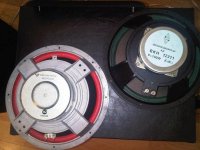 WOOFH-12211C.jpg68.3 KB · Views: 1,985
WOOFH-12211C.jpg68.3 KB · Views: 1,985 -
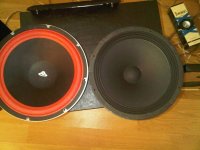 WOOFH-12211B.jpg56.1 KB · Views: 1,963
WOOFH-12211B.jpg56.1 KB · Views: 1,963 -
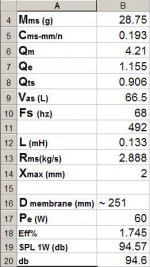 VK12350data.jpg30.9 KB · Views: 164
VK12350data.jpg30.9 KB · Views: 164 -
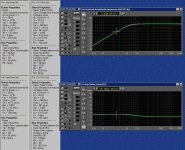 VegaVKNSBLinkwitz.jpg110.2 KB · Views: 103
VegaVKNSBLinkwitz.jpg110.2 KB · Views: 103 -
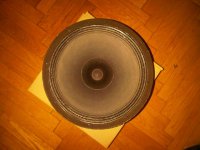 IMG02021-20111015-1802.jpg61.3 KB · Views: 139
IMG02021-20111015-1802.jpg61.3 KB · Views: 139 -
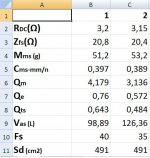 wofh12203TSDATA.jpg45.3 KB · Views: 128
wofh12203TSDATA.jpg45.3 KB · Views: 128 -
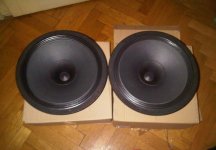 IMG020499-20111015-1808.jpg47 KB · Views: 134
IMG020499-20111015-1808.jpg47 KB · Views: 134 -
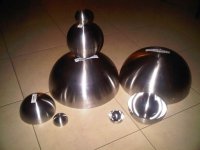 IMG02054-20111015-2012.jpg43.7 KB · Views: 1,997
IMG02054-20111015-2012.jpg43.7 KB · Views: 1,997 -
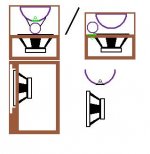 OmniVK12350.jpg14.1 KB · Views: 123
OmniVK12350.jpg14.1 KB · Views: 123
Last edited:
I'm not sure that sphere is the right shape for a lens. It may well mess up your wavefront something rotten. Also, the variable distance from driver to lens may cause non-linear pressure distribution. You'd perhaps want something that's shaped more like a parabolic cone? :
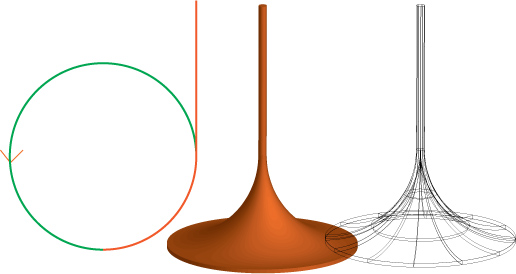
Just a hunch. Ikea probably have objects that shape that could be filled with something heavy.
Acoustic lenses are interesting. Moulton Laboratories :: A new loudspeaker design
But you know. Suck it and see. I say fill dem bowls full of sand, concrete or silicone sealant unless you want an electronically controlled gamelan...

Just a hunch. Ikea probably have objects that shape that could be filled with something heavy.
Acoustic lenses are interesting. Moulton Laboratories :: A new loudspeaker design
But you know. Suck it and see. I say fill dem bowls full of sand, concrete or silicone sealant unless you want an electronically controlled gamelan...
Last edited:

I like Your project, which reminds me a bit of the Omnisphere by Wolcott:
Wolcott Audio... Omnisphere Speaker System
however I like Your design better
I bought some little ones to play around with omni tweeters, need to get some measurement devices, sounded ok to me
Idea was to clone the Duevel Planets
Good luck
Idea was to clone the Duevel Planets
An externally hosted image should be here but it was not working when we last tested it.
Good luck
I'm not sure that sphere is the right shape for a lens. It may well mess up your wavefront something rotten. Also, the variable distance from driver to lens may cause non-linear pressure distribution. You'd perhaps want something that's shaped more like a parabolic cone? :

Just a hunch. Ikea probably have objects that shape that could be filled with something heavy.
Acoustic lenses are interesting. Moulton Laboratories :: A new loudspeaker design
But you know. Suck it and see. I say fill dem bowls full of sand, concrete or silicone sealant unless you want an electronically controlled gamelan...
Hi there!
At first I considered this shape, but my intention is for reflecting the sound only, not for some kind of front loading. If the "poppet" or "mushroom" (early Lowther omni designs), then if it is closer it would be some kind of loading, and if it is further, then it will discriminate the waves emitted by the outer part of the membrane as it's surface is not sloped enough there.
A sphere is cheaper, easier to obtain and is used in those: SonicFlare - Hi-Fi reviews, audio events, show coverage, photos and more Duevel Planet Review by Sandy Greene and Duevel high-end loudspeakers
And I have heard those. Pretty nice soundin miniature
I have heard these too: German Physiks - High End Technology Loudspeaker Manufactur - DDD Driver - Home - this time it is a direct radiator, it is very very detailed even artificially detailed micro sounds and very dynamic... but I'm not sure whether they are acoustically superior to the planets, I liked the spheres better although there is a difference in the position of listening, the spheres are lower and i have listened to them standing and the German Things I listened seated.
Never the less, spheres have proved to be suitable for the task, my initial experiments proved the same. Effortless sound that flows, very good stereo imaging no big flaws.
I even get the impression, that the reflector is not that critical at all.
This design solves the following issues effortlessly by it's nature:
- Baffle Step - no baffle step, you can even cover the horisontal baffle of the extended range with sound absorbing material, just in case some diffraction shows up;
- Phase, phase is seamless with LR-4:
A summary of the characteristics of a Linkwitz-Riley crossover:
1. Absolutely flat amplitude response throughout the passband with a steep 24 dB/octave rolloff rate after the crossover point.
2. The acoustic sum of the two driver responses is unity at crossover. (Amplitude response of each is -6 dB at crossover, i.e., there is no peaking in the summed acoustic output.)
3. Zero phase difference between drivers at crossover. (Lobing error equals zero, i.e., no tilt to the polar radiation pattern.) In addition, the phase difference of zero degrees through crossover places the lobe of the summed acoustic output on axis at all frequencies.
4. The low pass and high pass outputs are everywhere in phase. (This guarantees symmetry of the polar response about the crossover point.)
5. All drivers are always wired the same (in phase).
- time alignment, the central axis of the extended range can be exactly above the acoustic center of the bass driver, not that it matter at wavelengths of ~3.7 meters, the tweeter is directly above the extended range and is on the exact same central axis as it;
- directivity, up to 90-100 hz the bass monopole enclosure is practically an omni, at least they say so, everything above 90 hz is omni too, so no such thing as directivity here; Even Xdir doesn't draw it's usual horrific pictures with that imput data and 400 and 60mm distances respectively;
- Vertical dispersion, for first crossover region, see the above quote, the second crossover point fulfills the conditions for LR-2 with 90 degrees phase difference and -6 db at crossover point, drivers are again time aligned. Don't know about vertical dispersion of the spheres, but it should be above 90 degrees, I have read something about 120 degrees, but not backed with scientific or measured arguments.
- Linkwitz Transform allows the design to take advantage of the very small group delay of the sealed cabinets and even pushes the highest delay further down in frequency.
- Bi-amping and active signal level crossovers don't need describing.
Alright! It can't be that easy! I have just described the Holly Grail of speakers! There must be a catch. This cannot be the best speaker design concept. Are there any issues related to speaker design that are not addressed?
I can think of only one: impulse response in about 1/8th of octave around the crossover point is compromised - this is a known parameter of LR-4... But anything else apart from that?
Come on! You can't be weaker than my design? Catch it!
Best regards!
Hi there, the project is slowly evolving. I did some reverse engineering and found Visaton Fontana: Visaton - Lautsprecher und Zubehör, Loudspeakers and Accessories
It uses this tweeter: Visaton - Lautsprecher und Zubehör, Loudspeakers and Accessories
I had to search for a tweeter with response rising towards the HF to compensate for the "bowl treble fall". Omni designs need such drivers, because their FR is a representation of the proportion of the energy emitted in the different frequency ranges.
A driver that has flat on axis response will actually emit less energy in the high frequencies due to beaming.
See the DT94 directivity pattern. The 16 kHz contour has an area which is approximately half the area of the area of the contour of 8kHz and about 4 times smaller than the 4kHz contour.
If we make a rough approximation of the levels we'll see that the 16 kHz level is on average level of -10 db and the 8 kHz level is roughly on -5 db. So the same conclusions arise from that comparison as from the area comparison, each octave the overall emitted energy is at least halved. - no such thing can be observed on axis, but the phenomenon exists and affects the perceived sound field.
I got myself the 4 ohm version which has slightly more pronounced peak at 16-17 kHz making those frequencies ~5 db louder than 8 khz.
And I conducted some listening experiments. (see attached photos for details of the setups auditioned)
- Bare driver horisontaly;
- Driver with small half bowl standing directly on it;
- Driver with medium half bowl directly on it;
- Driver with whole bowl standing above it supported by wire stands. (assembled entirely with only a moment glue, 4mm2 hard wire and pliers)
The difference is hardly noticeable at first as there is not much material recorded above 10-12 kHz and the driver has tolerable dispersion up to almost there, so even at 90 degrees off axis the treble can seem unaffected. The ceiling is a big confusing factor too, if you audition a bare HF driver, it is hard to tell the difference as the HF energy is emitted in the room anyway.
Although hard, it was not impossible to distinguish the winner and it is the supported full sphere. Bare driver didn't have high treble - no surprise. The medium bowl made the sound pronouncedly congested so did the directly placed small bowl but to a lesser extent.
I liked it allot. Realistic treble and even with one driver, you can't tell where the sound is coming from. The small sphere is totally resonance or ringing free, it is rather thick wall and does not produce sound or resonance no matter how you stimulate it. For contrast a small bowl rings as a tiny door bell or as a small vintage clock, this totally disappears when you make a sphere out of two bowls.
Quite entertaining experience it was. And I am satisfied with the results.
I also made a very easy test crossover @ ~7.2 kHz @-3db 5uf and 0.5mH, see photos. I didn't have test inductances at hand, so I bought some tiny 0.40$ 1 ohm 1mh 0.4A inductances, which behaved quite neutrally at the test, no signs of saturation, distortion or blowing.
Best Regards!
It uses this tweeter: Visaton - Lautsprecher und Zubehör, Loudspeakers and Accessories
I had to search for a tweeter with response rising towards the HF to compensate for the "bowl treble fall". Omni designs need such drivers, because their FR is a representation of the proportion of the energy emitted in the different frequency ranges.
A driver that has flat on axis response will actually emit less energy in the high frequencies due to beaming.
See the DT94 directivity pattern. The 16 kHz contour has an area which is approximately half the area of the area of the contour of 8kHz and about 4 times smaller than the 4kHz contour.
If we make a rough approximation of the levels we'll see that the 16 kHz level is on average level of -10 db and the 8 kHz level is roughly on -5 db. So the same conclusions arise from that comparison as from the area comparison, each octave the overall emitted energy is at least halved. - no such thing can be observed on axis, but the phenomenon exists and affects the perceived sound field.
I got myself the 4 ohm version which has slightly more pronounced peak at 16-17 kHz making those frequencies ~5 db louder than 8 khz.
And I conducted some listening experiments. (see attached photos for details of the setups auditioned)
- Bare driver horisontaly;
- Driver with small half bowl standing directly on it;
- Driver with medium half bowl directly on it;
- Driver with whole bowl standing above it supported by wire stands. (assembled entirely with only a moment glue, 4mm2 hard wire and pliers)
The difference is hardly noticeable at first as there is not much material recorded above 10-12 kHz and the driver has tolerable dispersion up to almost there, so even at 90 degrees off axis the treble can seem unaffected. The ceiling is a big confusing factor too, if you audition a bare HF driver, it is hard to tell the difference as the HF energy is emitted in the room anyway.
Although hard, it was not impossible to distinguish the winner and it is the supported full sphere. Bare driver didn't have high treble - no surprise. The medium bowl made the sound pronouncedly congested so did the directly placed small bowl but to a lesser extent.
I liked it allot. Realistic treble and even with one driver, you can't tell where the sound is coming from. The small sphere is totally resonance or ringing free, it is rather thick wall and does not produce sound or resonance no matter how you stimulate it. For contrast a small bowl rings as a tiny door bell or as a small vintage clock, this totally disappears when you make a sphere out of two bowls.
Quite entertaining experience it was. And I am satisfied with the results.
I also made a very easy test crossover @ ~7.2 kHz @-3db 5uf and 0.5mH, see photos. I didn't have test inductances at hand, so I bought some tiny 0.40$ 1 ohm 1mh 0.4A inductances, which behaved quite neutrally at the test, no signs of saturation, distortion or blowing.
Best Regards!
Attachments
-
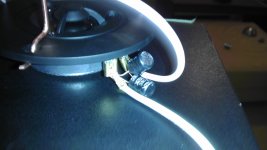 IMAG0077.jpg480.8 KB · Views: 228
IMAG0077.jpg480.8 KB · Views: 228 -
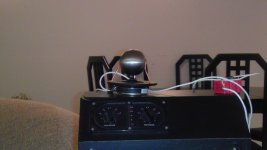 IMAG0073.jpg414.2 KB · Views: 323
IMAG0073.jpg414.2 KB · Views: 323 -
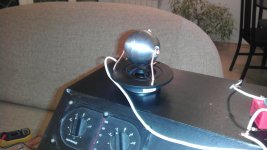 IMAG0070.jpg551.4 KB · Views: 491
IMAG0070.jpg551.4 KB · Views: 491 -
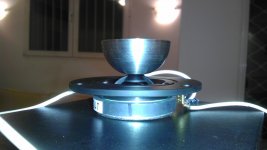 IMAG0068.jpg478.8 KB · Views: 510
IMAG0068.jpg478.8 KB · Views: 510 -
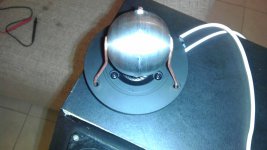 IMAG0079.jpg554.3 KB · Views: 375
IMAG0079.jpg554.3 KB · Views: 375 -
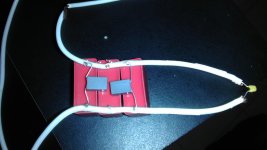 IMAG0075.jpg524.2 KB · Views: 236
IMAG0075.jpg524.2 KB · Views: 236 -
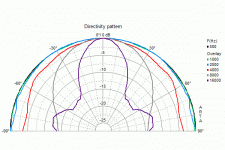 dt94_rd.gif12 KB · Views: 235
dt94_rd.gif12 KB · Views: 235 -
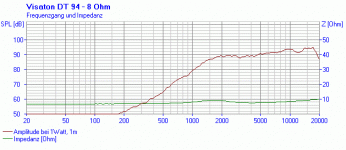 dt94_8_fs.gif7.7 KB · Views: 204
dt94_8_fs.gif7.7 KB · Views: 204 -
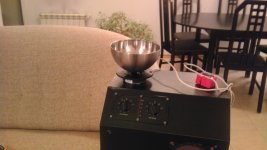 IMAG0088.jpg597.9 KB · Views: 340
IMAG0088.jpg597.9 KB · Views: 340
Last edited:
T101,
How has your project progressed? I'm interested in trying an omni design for ambient music in my dining room and perhaps for surround sound duty.
Also, have you tried wood bowls or spheres? I would imagine there would be a degree of HF absorption, but they are cheaper and more readily available.
Thanks in advance.
How has your project progressed? I'm interested in trying an omni design for ambient music in my dining room and perhaps for surround sound duty.
Also, have you tried wood bowls or spheres? I would imagine there would be a degree of HF absorption, but they are cheaper and more readily available.
Thanks in advance.
Hi there,
I advance very slowly.
The active LR-4 crossovers @85 hz are ready. But have in mind, that it's a very simple build, 50L sealed enclosure with ~30L breathing (sealed/aperiodic) enclosure on top. And have in mind, that I will have the 4 channel amplifier custom built for the system. This is the slowing down fragment.
As for the bowls, it's the opposite, the inox ones are the cheaper and the wood oneas are the more expensive. All bowls pictured here cost ~$34.50.
The treble sounds beautiful and I managed to conduct some improvised tests with the 12 inch fullrange and the big bowls and it sounded beautiful as well.
A curious fact: recently we had a Hi-Fi and Hi-end expo here. It was held at a hotel in the downtown and the acoustic environment was in the sub tragic category. Almost no one of the visitors ever heard bass at all and the sub 1000 hz region and the high treble were also spoiled at all systems - epic fail of and expo as they say. The only speakers that performed at a level above average were the onmi ones. And this is all omnis from god knows how much hundred thousand dollars monster MBL down to Duevel Planets and more expensive Duevels and German Phisics...
This just reassured me that the omni speakers are the ones which adapt to the environment best.
As for the project in one of the coming months I will most probably handle a detailed plan to a carpenter for the boxes. But I haven't still decided whether to make a provision for bowlless upright operation of the upper part or not. Also I am still concerned with the total height of the speakers, whether to extend them to above 1000mm (~39.4 in) or to keep them compact. Probably will make them shorter and more wider and deeper in order to make them more appealing... a stand can always be added...
Here are photos of the crossovers and some measured actual crossover response response - just to render some activity on the project.
Best Regards!
I advance very slowly.
The active LR-4 crossovers @85 hz are ready. But have in mind, that it's a very simple build, 50L sealed enclosure with ~30L breathing (sealed/aperiodic) enclosure on top. And have in mind, that I will have the 4 channel amplifier custom built for the system. This is the slowing down fragment.
As for the bowls, it's the opposite, the inox ones are the cheaper and the wood oneas are the more expensive. All bowls pictured here cost ~$34.50.
The treble sounds beautiful and I managed to conduct some improvised tests with the 12 inch fullrange and the big bowls and it sounded beautiful as well.
A curious fact: recently we had a Hi-Fi and Hi-end expo here. It was held at a hotel in the downtown and the acoustic environment was in the sub tragic category. Almost no one of the visitors ever heard bass at all and the sub 1000 hz region and the high treble were also spoiled at all systems - epic fail of and expo as they say. The only speakers that performed at a level above average were the onmi ones. And this is all omnis from god knows how much hundred thousand dollars monster MBL down to Duevel Planets and more expensive Duevels and German Phisics...
This just reassured me that the omni speakers are the ones which adapt to the environment best.
As for the project in one of the coming months I will most probably handle a detailed plan to a carpenter for the boxes. But I haven't still decided whether to make a provision for bowlless upright operation of the upper part or not. Also I am still concerned with the total height of the speakers, whether to extend them to above 1000mm (~39.4 in) or to keep them compact. Probably will make them shorter and more wider and deeper in order to make them more appealing... a stand can always be added...
Here are photos of the crossovers and some measured actual crossover response response - just to render some activity on the project.
Best Regards!
Attachments
- Status
- This old topic is closed. If you want to reopen this topic, contact a moderator using the "Report Post" button.
- Home
- Loudspeakers
- Multi-Way
- Ikea Omni Bowl Speakers
